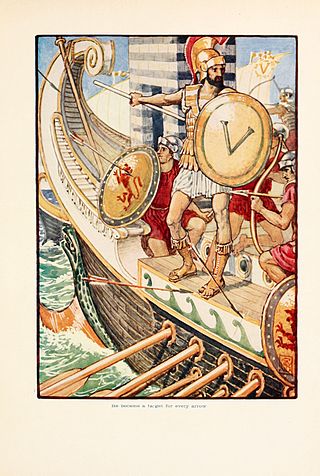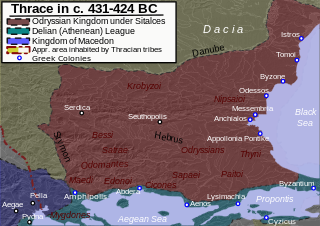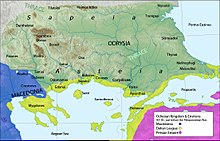
Amphipolis was an important ancient Greek polis (city), and later a Roman city, whose large remains can still be seen. It gave its name to the modern municipality of Amphipoli, in the Serres regional unit of northern Greece.

The Second Peloponnesian War, often called simply the Peloponnesian War, was an ancient Greek war fought between Athens and Sparta and their respective allies for the hegemony of the Greek world. The war remained undecided until the later intervention of the Persian Empire in support of Sparta. Led by Lysander, the Spartan fleet finally defeated Athens which began a period of Spartan hegemony over Greece.
In Greek mythology, Oeagrus was a king of Thrace, and father of Orpheus.

Brasidas was the most distinguished Spartan officer during the first decade of the Peloponnesian War. He died during the Second Battle of Amphipolis while winning one of his most spectacular victories.

Perdiccas II was the king of Macedonia from 454 BC until his death in 413 BC. During the Peloponnesian War, he frequently switched sides between Sparta and Athens.

The Battle of Amphipolis was fought in 422 BC during the Peloponnesian War between Athens and Sparta. It was the culmination of events that began in 424 BC with the capture of Amphipolis by the Spartans.

In antiquity, Paeonia or Paionia was the land and kingdom of the Paeonians or Paionians.

In Greek mythology, Lycurgus was the king of the Edoni in Thrace, son of Dryas, the "oak", and father of a son whose name was also Dryas.

The Odrysian kingdom was an ancient Thracian state that thrived between the early 5th century BC and the early 3rd / late 1st century BC. Located in present-day Bulgaria, southeastern Romania, northern Greece and European Turkey, it was a tribal amalgam dominated by the Odrysians that was the first large political entity to develop in the eastern Balkans.
Charidemus, of Oreus in Euboea, was an ancient Greek mercenary leader of the 4th century BC. He had a complicated relationship with Athens, sometimes aiding the city in its efforts to secure its interests in the northern Aegean, sometimes working against it. He was castigated by Demosthenes in his oration Against Aristocrates for repeated treacherous actions toward Athens, yet later he received Athenian citizenship and was elected one of its generals. In this capacity he ran afoul of Alexander III of Macedon and was ordered into banishment after the destruction of Thebes in 335. He retired to Persia, where he was first honored by the Great King, but was later executed after sneering at the quality of the Persian army.

Eion, ancient Chrysopolis, was an ancient Greek Eretrian colony in Thracian Macedonia specifically in the region of Edonis. It sat at the mouth of the Strymon River which flows into the Aegean from the interior of Thrace. It is referred to in Thucydides' History of the Peloponnesian War as a place of considerable strategic importance to the Athenians during the Peloponnesian War.
Hagnon, son of Nikias was an Athenian general and statesman. In 437/6 BC, he led the settlers who founded the city of Amphipolis in Thrace; in the Peloponnesian War, he served as an Athenian general on several occasions, and was one of the signers of the Peace of Nicias and the alliance between Athens and Sparta. In 411 BC, during the oligarchic coup, he supported the oligarchy and was one of the ten commissioners (probouloi) appointed to draw up a new constitution.
Bistones is the name of a Thracian people who dwelt between Mount Rhodopé and the Aegean Sea, beside Lake Bistonis, near Abdera extending westward as far as the river Nestus. It was through the land of the Bistones that Xerxes marched on his invasion of Greece. The Bistones continued to exist at the time when the Romans were masters of Thrace. Roman poets sometimes use the names of the Bistones for that of the Thracians in general. Pliny mentions one town as belonging to the Bistones: Tirida; the other towns on their coast, Dicaea, Ismaron, Parthenion, Phalesina and Maronea, were Greek colonies.
Bottiaeans or Bottiaei were an ancient people of uncertain origin, living in Central Macedonia. Sometime, during the Archaic period, they were expelled by Macedonians from Bottiaea to Bottike. During the Classical era, they played an active role in the military history of ancient Chalcidice, but after the Macedonian conquest under Philip II nothing remained except the names of these two regions and the adjective Bottiaean, which was limited to sole geographical meaning. Unlike other tribes of Macedonia ruled by kings or living in villages, Bottiaeans developed some polis form of self-government. Unfortunately, no Bottiaean individual is known to us and the limited historical or archaeological sources shed no further light.
In Greek mythology, Edonus was the ancestor of the Edonians in Thrace and Thracian Macedonia. He was the son of Ares and Calliope. The names Edonus, Edonian, Edonic is therefore used also in the sense of "Thracian", and as Thrace was one of the principal seats of the worship of Dionysus, it further signifies "Dionysiac" or "Bacchantic".

Under the reign of Philip II, the ancient kingdom of Macedonia, initially at the periphery of classical Greek affairs, came to dominate Ancient Greece in the span of just 25 years, largely thanks to the character and policies of its king. In addition to utilising effective diplomacy and marriage alliances to achieve his political aims, Philip II was responsible for reforming the ancient Macedonian army into an effective fighting force. The Macedonian phalanx became the hallmark of the Macedonian army during his reign and the subsequent Hellenistic period. His army and engineers also made extensive use of siege engines. Chief among Philip's Thracian enemies was the ruler Kersebleptes, who may have coordinated a temporary alliance with Athens. In a series of campaigns stretching from 356 to 340 BC, Philip II managed to ultimately subjugate Kersebleptes as a tributary vassal, conquering much of Thrace in the process. Philip II also fought against the Illyrian king Bardylis, who threatened Macedonia proper, and against Grabos II and Pleuratus in Illyria. In his newly conquered territories, he founded new cities such as Philippi, Philippopolis, Herakleia Sintike, and Herakleia Lynkestis.

Odomanti or Odomantes were an ancient tribe. Some regard it as Paeonian, while others claim, that the tribe was with certainty Thracian. The Odomanti are noted by Herodotus, Thucydides, Stephanus of Byzantium and Pliny the Elder.
Myrcinus or Myrkinos was an ancient Greek city located in Macedonian Thrace, in the region of Edonis between the Strymon and the Nestos Rivers, on the left bank of the Strymon. It was within the territory of the Edonians, a Thracian tribe, and was founded as a polis by colonists from Miletus in 497 BCE. The colonists were led by Histiaios, whom Darius had allowed to build a city in reward for his help. Its site offered great advantages to settlers, as it contained an abundant supply of timber for shipbuilding, as well as silver mines. Aristagoras retired to this place, and, soon after landing, perished before some Thracian town which he was besieging. Afterwards, it had fallen into the hands of the Edoni; but on the murder of Pittacus, chief of that people, it surrendered to Brasidas after he captured Amphipolis, Oesyme and Galepsus in 422 BCE. During the Byzantine empire it was known as Doxompos (Δοξόμπος) or Doxompus (Δοξόμπους).
The Lycurgeia is a lost tetralogy by the Athenian dramatist Aeschylus that concerned Thracian Lycurgus' conflict with Dionysus and its aftermath. The four plays that made up the Lycurgeia survive only in fragments quoted by ancient authors, and the reconstruction of much of their content is a matter of conjecture. In the Edoni, Dionysus presumably arrived in Thrace where King Lycurgus attempted to suppress the worship of the new god. The second play, the Bassarids, is supposed to have treated the death of Orpheus at the hands of Thracian women in the thrall of Dionysus. Very little is known of the third play, the Youths, but M.L. West has proposed that it culminated in the acceptance of the cult of Dionysus in Thrace. The satyr play was named Lycurgus after the king and might have presented his attempt to domesticate the satyrs, civilizing their bestial nature and forcing them to perform at his feasts in "honour not of Dionysus, but of himself and Ares."

Edonis or Edonida, also transliterated as Edonia, was an ancient region of Thrace which later became a district of Macedon. Its name is derived from the ancient Thracian inhabitants of the region, the Edonians. Later, the Greeks settled in the region, drove out the Edonians and built several colonies, including Amphipolis and Eion. It was bordered by Odomantice in the north, Bisaltia in the west, and the Aegean Sea in the south, and was separated from Thrace proper by the river Nestos in the east.












